-
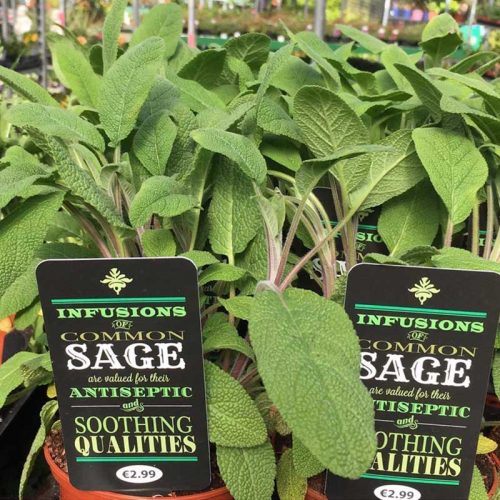 A yellow variegated form of sage. Used to flavour poultry and also popular in stuffing, sausages, roast, and strongly flavoured foods.
A yellow variegated form of sage. Used to flavour poultry and also popular in stuffing, sausages, roast, and strongly flavoured foods. -
Out of stock
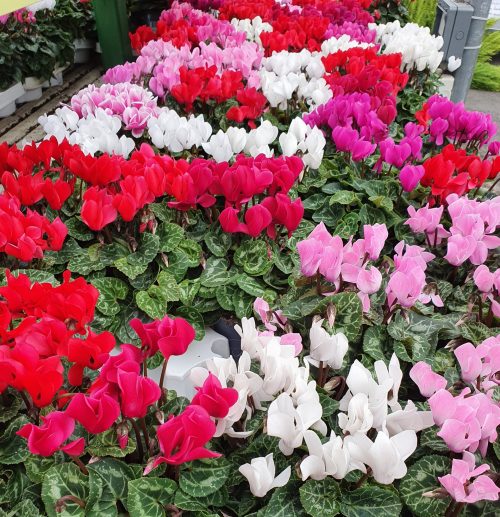
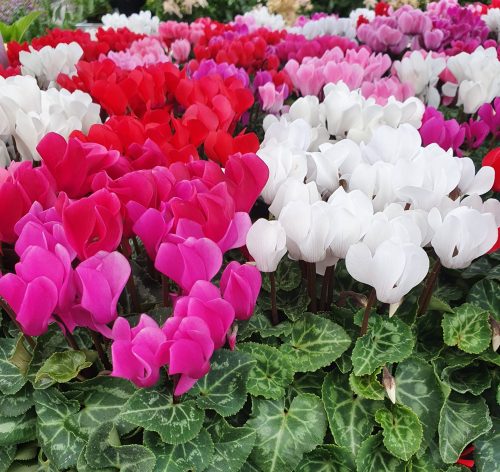 The life cycle of hardy cyclamen is unusual. It begins in September when dozens of small pink flowers begin to bloom before the leaves emerge. Each flower is on a separate 4 ” stem and looks just like a miniature florist cyclamen flower with gorgeous reflexed petals. The flowers continue to be produced abundantly in succession through out the months of September and October and sometimes for parts of August and November too. They emerge slowly as the flowers are blooming in late September and take several weeks to reach their full size. “Variable” is an understatement to describe their wonderful shapes, patterns, and colors. They can be round to lance-shaped, lobed or entire, serrated or smooth edged, dark green to silver. And the patterns on the leaves are indescribable. They stay green and fresh all winter! Instead of going dormant in the winter like most of our plants, hardy cyclamen goes dormant for a few months during the summer.
The life cycle of hardy cyclamen is unusual. It begins in September when dozens of small pink flowers begin to bloom before the leaves emerge. Each flower is on a separate 4 ” stem and looks just like a miniature florist cyclamen flower with gorgeous reflexed petals. The flowers continue to be produced abundantly in succession through out the months of September and October and sometimes for parts of August and November too. They emerge slowly as the flowers are blooming in late September and take several weeks to reach their full size. “Variable” is an understatement to describe their wonderful shapes, patterns, and colors. They can be round to lance-shaped, lobed or entire, serrated or smooth edged, dark green to silver. And the patterns on the leaves are indescribable. They stay green and fresh all winter! Instead of going dormant in the winter like most of our plants, hardy cyclamen goes dormant for a few months during the summer. -
Out of stock
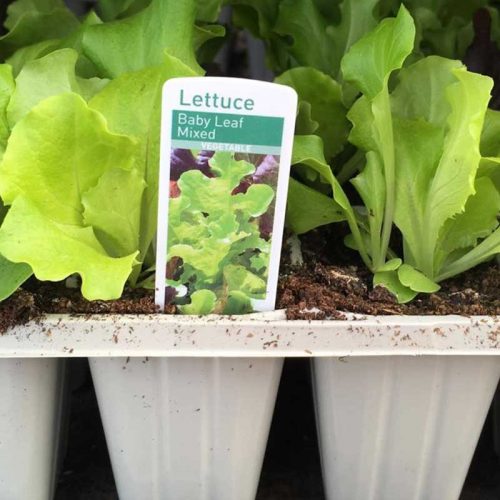
-
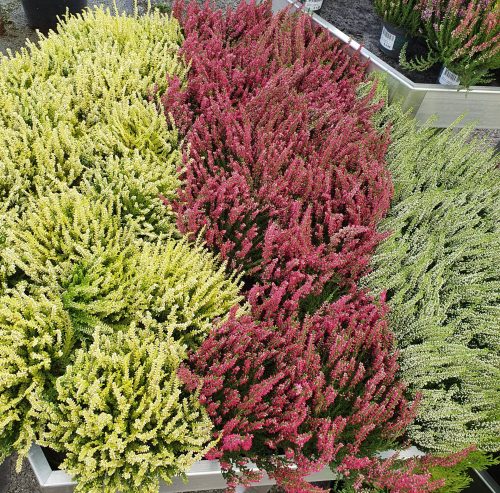
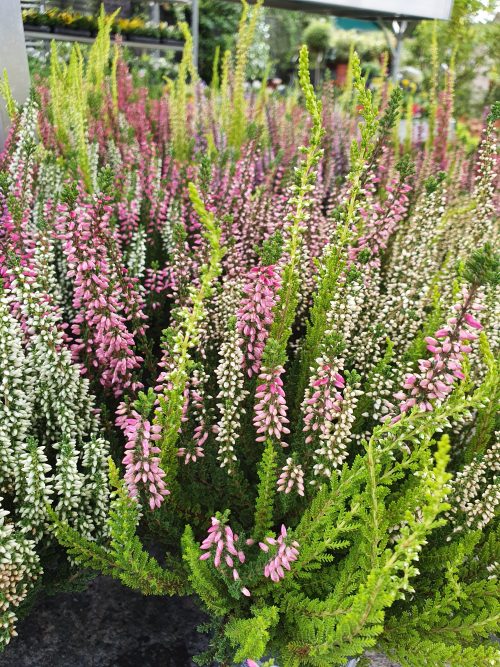 Calluna vulgaris, also known as common Scotch Heather is a low growing perennial shrub; it blooms with very long lasting, sweet smelling flowers in late summer that will attract many insects with their sweet nectar in late summer. Their dense spreading habit makes them perfect as a ground covering plant or for a charming display on your patio or balcony.
Calluna vulgaris, also known as common Scotch Heather is a low growing perennial shrub; it blooms with very long lasting, sweet smelling flowers in late summer that will attract many insects with their sweet nectar in late summer. Their dense spreading habit makes them perfect as a ground covering plant or for a charming display on your patio or balcony.- Fragrant
- Covers bare spots quickly
- Bee Friendly
- Blooms: August - September
- Flower colour: red
- Full grown height: 25 - 50 cm
- Full grown width: 10 - 25 cm
- Plant location: sunny
- Plant spacing: 35 cm
- Hardiness: -15 Celsius
- Preferred soil: Peaty Soil
-
Out of stock
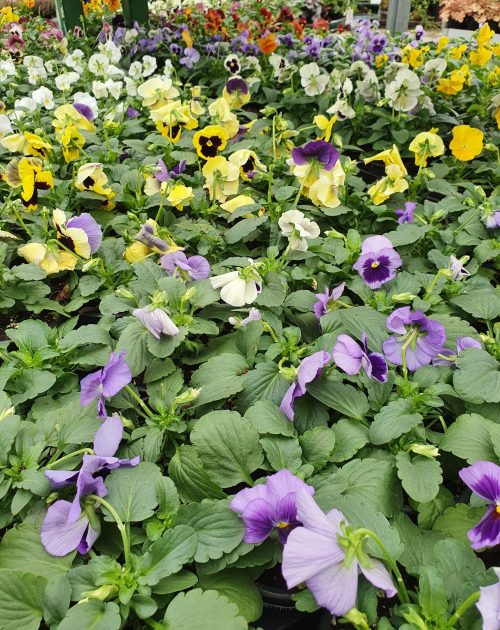
Pansy
The most popular and best loved. It will perform in your garden whether in a container or planted out into the borders etc. Totally Winter hardy. Flowers from end August - next August (if looked after!) Typically the pansies are termed as Winter pansies and will flower through the Winter providing there are plenty of sunny days. They require the sun to initiate flower bud and in the sometimes dreary, dull days that Winter offer they maybe shy to flower. The reward is usually around the end of February onwards the first Spring flush of vibrant colours lift the garden into joy. Unlike a lot of bedding plants, pansy & especially viola are easy to keep looking good providing a few basics are given. Watering is best done in morning, keep drier during the winter months - but at the same time don't let them dry out completely. Feed with a high potash feed such as vitax , once established. If you are time strapped we suggest adding slow release food in the compost at time of planting with Vitax Q4 or Gro-Sure. This should provide enough nutrient for 6 months, but frequency of watering may effect this. De-head regurlarly to keep the plant producing more flowers and for disease prevention. The smaller violas are self-cleaning, ie. de heading not neccessary. Pest & disease problems? If the plants are kept healthy with good watering and de heading & dead leaf removal the plants will be trouble free. Pests. Caterpillars are the main issue. If you are environmentally minded, pick off any you see. However, a spray with systemic insecticide will do the trick. Slugs can often eat the flower buds, leaves & stems so watch out for them. Disease. There can be leaf spot and downy mildew problems. This mainly happens if we get a dull wet Winter. Try to keep plants dry and remove any affected leaves straight away. Preventitive fungicides can work if applied correctly. -
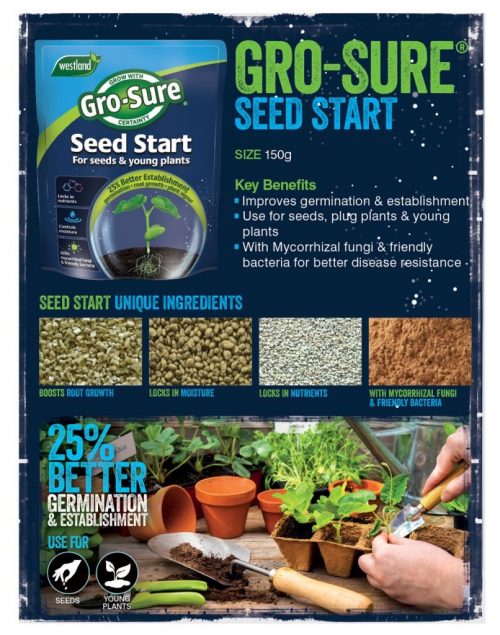
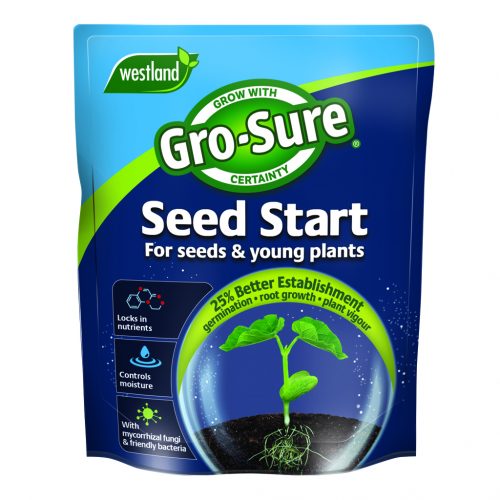 Gro-Sure Seed Start’s natual blend of mycorrhizal fungi and friendly bacteria improves germination and establishment of seeds and young plants.
Gro-Sure Seed Start’s natual blend of mycorrhizal fungi and friendly bacteria improves germination and establishment of seeds and young plants.- 25% better establishment
- Boosts root growth
- Locks in nutrients
- Controls moisture
- Contains mycorrhizal fungi and friendly bacteria
- Water is held around the seed to aid germination
- Mycorrhizal fungi & friendly bacteria enhance root development
- Nutrients are held in the soil and feed the plant during the establishment
- Seeds must be kept constantly moist to soften the seed shell in order for germination to take place
- Seeds must be moist, NOT wet. Insufficient moisture or erratic watering slows down or stops the germination process. Our added wetting agent locks in moisture around the seed and therefore germination is improved
- Added clinoptiloite, a natural zeolite or volcanic rock dust, contains an array of basic nutrients and its crystalline structure grabs hold of other available nutrients in the soil stopping them being leached away
- These nutrients are available to the root system of the plant while its structure also aerates the soil. Roots need to breathe
- Vermiculite opens up the growing medium so young roots can permeate more easily. Holding a considerable amount of moisture like a sponge it can also act as blanket to help keep seedlings warm and is particularly good for lightly covering sown seedlings
- Fortified with beneficial mycorrhizal fungi which attach to the developing plants’ roots in exchange for some plant sugars. They quickly multiply forming their own extensive root supply, which absorbs nutrients and water to feed back to their host plant.
- The plant’s absorptive root system is increased greatly and the plant is able to grow faster and stronger
- Our blend of naturally occurring ‘friendly’ soil bacteria’s including trichoderma and bacillus colonise the root system. Because each pack of Seed Start contains millions of friendly bacteria they out-compete harmful soil pathogens within the soil, which cause plant diseases. It does all of this while also releasing locked up nutrients within the soil for the plants roots to uptake
-
Out of stock
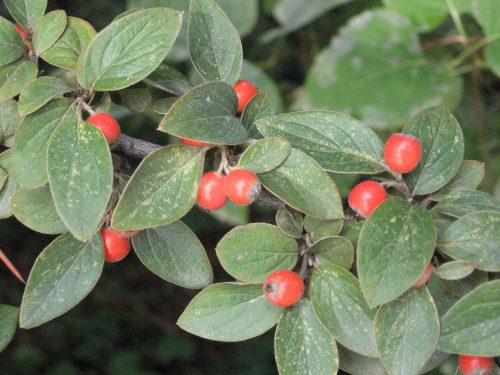
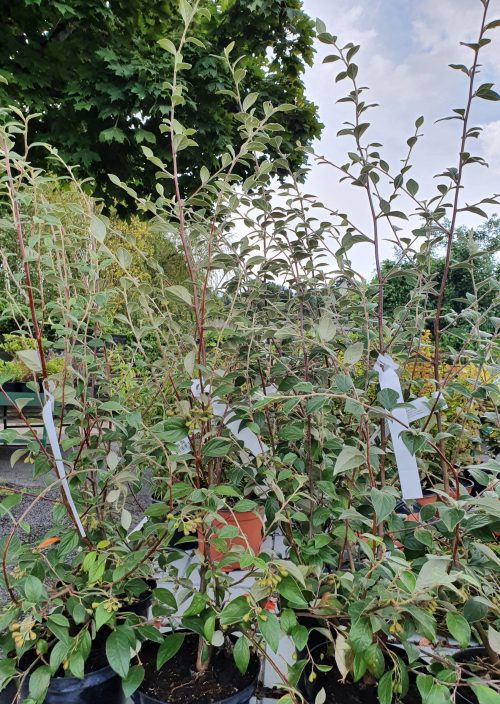 Franchet's Cotoneaster is a popular ornamental semi- evergreen shrub that produces masses of white flowers, during the summer followed by bright orange-red fruit in autumn. Its dense foliage makes it sought after by pollinating insects. Its easy to maintain and is fast-growing. Can also be used as a hedge, making it valuable shrub for both the gardener and the landscaper.Evergreen
Franchet's Cotoneaster is a popular ornamental semi- evergreen shrub that produces masses of white flowers, during the summer followed by bright orange-red fruit in autumn. Its dense foliage makes it sought after by pollinating insects. Its easy to maintain and is fast-growing. Can also be used as a hedge, making it valuable shrub for both the gardener and the landscaper.Evergreen- Blooms: May - June
- Flower colour: white
- Full grown: 5 Years
- Full grown height: 50 - 75 cm
- Full grown width: 75 - 100 cm
- Plant location: partial sunny location
- Plant spacing: 100 cm
- Hardiness: -25 Celsius
- Preferred soil: Well drained
-
Out of stock
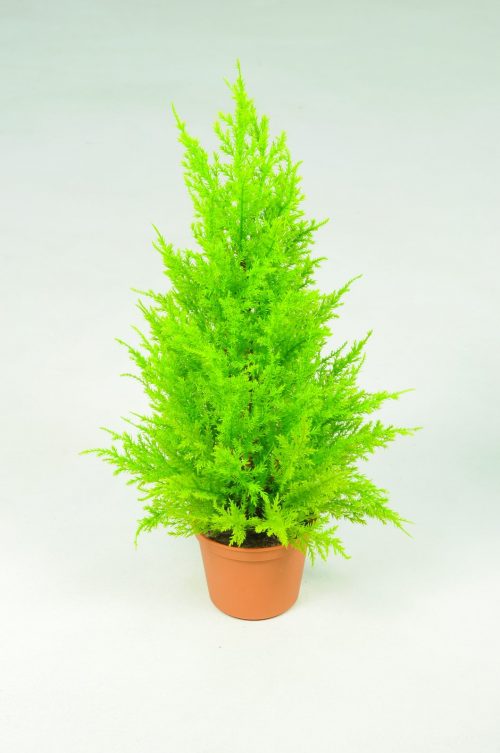 Cupressus macrocarpa 'Goldrest Wilma' is one of the most attractive golden-foliage columnar conifers. Bright golden-yellow foliage. Any free-draining soil in sun or partial shade. Rate of growth up to 60cm per year. Can be used for hedging but doesn't trim quite as well as leylandii. If used for hedging, plant 60-90cm apart. Can be trimmed to keep at the required height Plant Size • Mature Height: 10m • Mature Spread: 2-3m Why We Love It • These trees work wonderfully as topiaries • Fresh lemony scent • Easy to maintain What To Know • Fruit Season: Fall • Position: Full sun • Soil: Well drained • Rate of Growth: Moderate to fast How to Care • In general, growing lemon cypress is not difficult. The trees require well-draining soil, but are not picky about whether it is loamy, sandy or chalky. They also accept acidic, neutral or alkaline soil. • Water regularly - weekly, or more often in extreme heat or containers. • Trimming/Pruning If this plant is used for hedging, it will need to be pruned regularly. It will have to be trimmed to maintain the required height. Use sharp pruning shears to remove the sucker branches and the errant branches that are growing in the wrong direction or making it difficult to fertilize the tree. Since lemon cypress has a conical habit, trim the tree as per its natural shape. Trimming should be done every week during the summer. • Fertilizer Fertilize with the standard, slow-releasing fertilizer that has an equal amount of nitrogen, phosphorus, and potassium once a month. You can also supplement the soil annually with turf fertilizers that contain other nutrients such as magnesium, boron, copper, and zinc
Cupressus macrocarpa 'Goldrest Wilma' is one of the most attractive golden-foliage columnar conifers. Bright golden-yellow foliage. Any free-draining soil in sun or partial shade. Rate of growth up to 60cm per year. Can be used for hedging but doesn't trim quite as well as leylandii. If used for hedging, plant 60-90cm apart. Can be trimmed to keep at the required height Plant Size • Mature Height: 10m • Mature Spread: 2-3m Why We Love It • These trees work wonderfully as topiaries • Fresh lemony scent • Easy to maintain What To Know • Fruit Season: Fall • Position: Full sun • Soil: Well drained • Rate of Growth: Moderate to fast How to Care • In general, growing lemon cypress is not difficult. The trees require well-draining soil, but are not picky about whether it is loamy, sandy or chalky. They also accept acidic, neutral or alkaline soil. • Water regularly - weekly, or more often in extreme heat or containers. • Trimming/Pruning If this plant is used for hedging, it will need to be pruned regularly. It will have to be trimmed to maintain the required height. Use sharp pruning shears to remove the sucker branches and the errant branches that are growing in the wrong direction or making it difficult to fertilize the tree. Since lemon cypress has a conical habit, trim the tree as per its natural shape. Trimming should be done every week during the summer. • Fertilizer Fertilize with the standard, slow-releasing fertilizer that has an equal amount of nitrogen, phosphorus, and potassium once a month. You can also supplement the soil annually with turf fertilizers that contain other nutrients such as magnesium, boron, copper, and zinc -
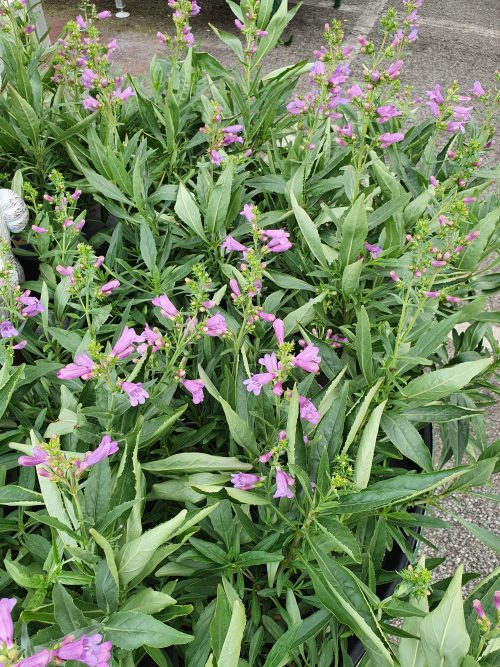 Penstemon are a genus of plants that are annual or perennial,most being semi-evergreen or evergreen.Fully to half hardy,these true conoisseur's plants carry sprays of tubular foxglove like flowers throughout the summer. Penstemons signal warm summer days and are excellent for cottage gardens,borders and summer tubs. Pot size: 1.5L Flowering time: all summer long Position: likes full sun and well drained fertile soil
Penstemon are a genus of plants that are annual or perennial,most being semi-evergreen or evergreen.Fully to half hardy,these true conoisseur's plants carry sprays of tubular foxglove like flowers throughout the summer. Penstemons signal warm summer days and are excellent for cottage gardens,borders and summer tubs. Pot size: 1.5L Flowering time: all summer long Position: likes full sun and well drained fertile soil -
Out of stock
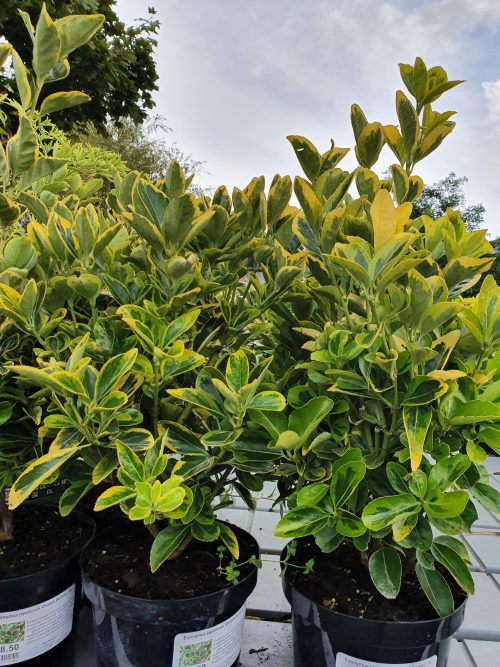 Euonymus Japonicus Aureus is an evergreen variety and provides year round interest. Excellent for growing as a specimen shrub or small hedge. Also suitable for coastal areas. The attractive leathery leaves are dark green with bright yellow edges.Decorative foliage
Euonymus Japonicus Aureus is an evergreen variety and provides year round interest. Excellent for growing as a specimen shrub or small hedge. Also suitable for coastal areas. The attractive leathery leaves are dark green with bright yellow edges.Decorative foliage -
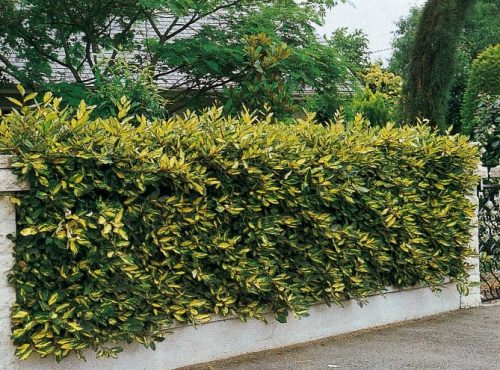
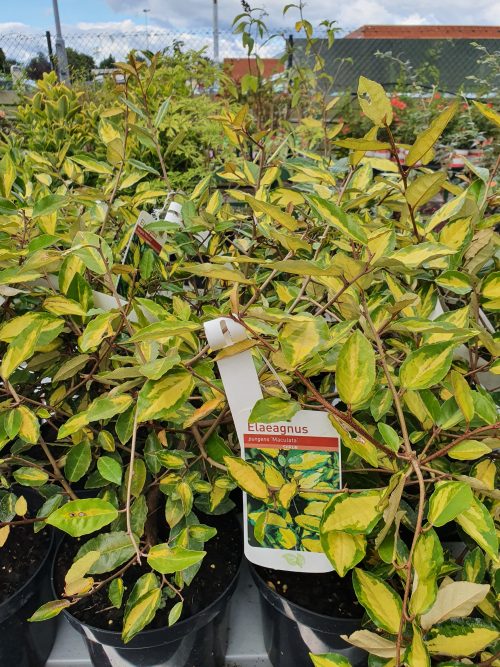 The Elaeagnus Pungens Maculata is a beautiful and colourful, bushy evergreen hedge. It has scaly leaves that are silver in colour, however they soon turn into a mature yet young looking vibrant yellow and green colour. It produces small, scented, white tubular flowers during the autumnal months that are followed by fruit that is small and juicy in the spring. The Elaeagnus Pungens Maculata prefers soil that is either sand, loam, chalk or clay, but must be well drained. It can either be planted in a sunny position or where there is partial shade, and it doesn’t mind whether that is in an exposed or sheltered position. It can grow up to four metres high and between two and a half to four meters wide in two to five years, which is quicker than the rest of its family. On average, it will grow up to one foot a year. It’s best to prune these during the late spring, preferably in either April or May, once it has finished producing its fruit. When it comes to planting the Elaeagnus Pungens Maculata we would suggest to plant it eighteen to twenty-four inches apart from one another. It works really well as an all year privacy hedge thanks to being evergreen. We have a range of Elaeagnus Pungens Maculata plants available in pot form.
The Elaeagnus Pungens Maculata is a beautiful and colourful, bushy evergreen hedge. It has scaly leaves that are silver in colour, however they soon turn into a mature yet young looking vibrant yellow and green colour. It produces small, scented, white tubular flowers during the autumnal months that are followed by fruit that is small and juicy in the spring. The Elaeagnus Pungens Maculata prefers soil that is either sand, loam, chalk or clay, but must be well drained. It can either be planted in a sunny position or where there is partial shade, and it doesn’t mind whether that is in an exposed or sheltered position. It can grow up to four metres high and between two and a half to four meters wide in two to five years, which is quicker than the rest of its family. On average, it will grow up to one foot a year. It’s best to prune these during the late spring, preferably in either April or May, once it has finished producing its fruit. When it comes to planting the Elaeagnus Pungens Maculata we would suggest to plant it eighteen to twenty-four inches apart from one another. It works really well as an all year privacy hedge thanks to being evergreen. We have a range of Elaeagnus Pungens Maculata plants available in pot form. -
Out of stock
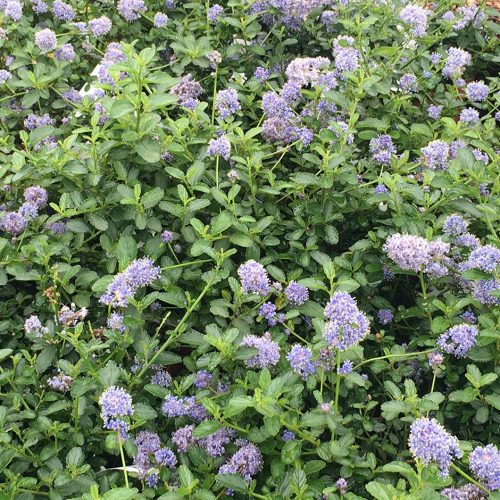
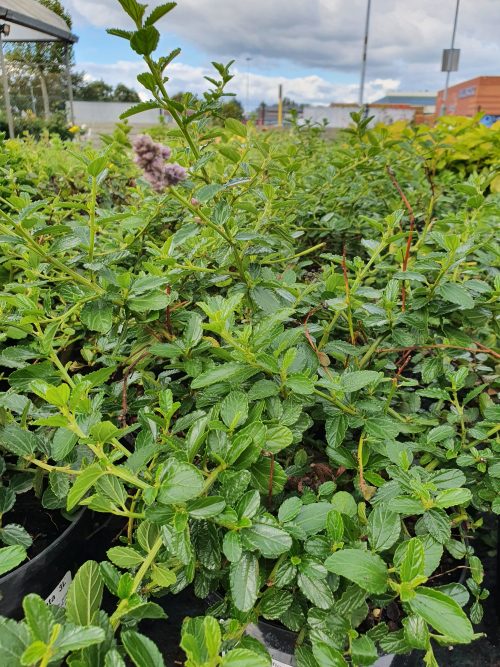 A deep blue flowering bushy garden shrub, which produces a wealth of deep powder blue flower heads from late spring into summer, combined with its glossy evergreen foliage. They’re fast growing and will be an asset to any garden!Covers bare spots quicklyBee friendly
A deep blue flowering bushy garden shrub, which produces a wealth of deep powder blue flower heads from late spring into summer, combined with its glossy evergreen foliage. They’re fast growing and will be an asset to any garden!Covers bare spots quicklyBee friendly- Covers bare spots quickly
- Bee Friendly
- Blooms: July - September
- Flower colour: blue
- Full grown height: 75 - 100 cm
- Full grown width: 1 - 1.50 m
- Plant location: sunny
- Plant spacing: 150 cm
- Hardiness: -10 Celsius
- Preferred soil: Grows in any soil
-
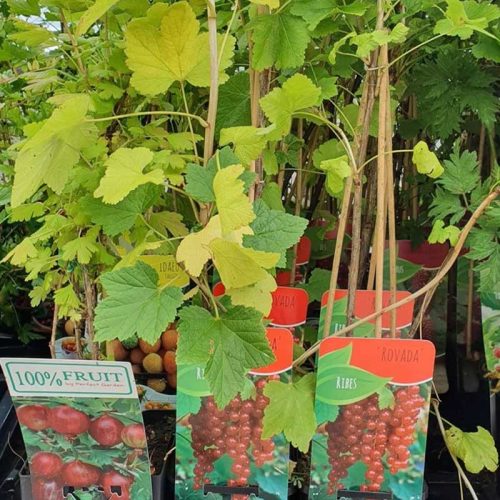
- Position:sunny or partly shaded north facing wall/fence sheltered from frost and strong winds. Plant 1.5m (5ft) apart in rows 1.5m (5ft) apart.
- Soil:slightly acid, moist but well-drained fertile soil.
- After care: Cut back the main branches by one-half after planting. Create a framework of 8-10 branches. Each Winter from year 3 shorten main shoots by one-half. Apply a general fertiliser in Spring.
-
Out of stock
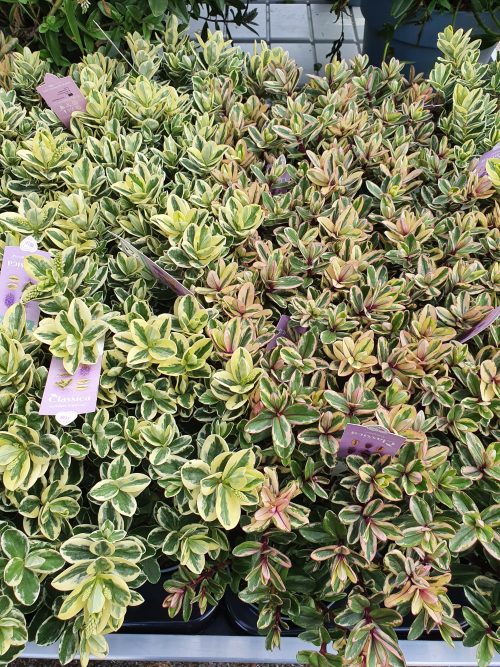 Katrina' is a compact, upright, bushy, evergreen shrub bearing broadly elliptic, grey-green leaves with pale yellow margins and dense racemes of purple flowers in summer. Plant Size • Mature Height: 0.5-1m • Mature Spread: 0.5-1m Why We Love It • Excellent addition to beds, borders and containers • Attracts butterflies and bees What To Know • Season of Interest: Winter-Autumn • Position: Full sun, partial shade • Soil: Moist, well-drained How to Care • The hebe plant does not require a lot of care once it is established. Although the shrub doesn’t need much in the way of fertilizer, you can apply some once a year in late winter or early spring prior to new growth. • Deadheading the spent blooms can be done to help promote additional flowering. You can also trim hebe plants back about halfway after flowering to promote bushier growth. • These shrubs are usually propagated through both seeds and semi-hardwood cuttings taken in summer. • In areas with harsher winters, they should be protected by surrounding them with straw mulch.
Katrina' is a compact, upright, bushy, evergreen shrub bearing broadly elliptic, grey-green leaves with pale yellow margins and dense racemes of purple flowers in summer. Plant Size • Mature Height: 0.5-1m • Mature Spread: 0.5-1m Why We Love It • Excellent addition to beds, borders and containers • Attracts butterflies and bees What To Know • Season of Interest: Winter-Autumn • Position: Full sun, partial shade • Soil: Moist, well-drained How to Care • The hebe plant does not require a lot of care once it is established. Although the shrub doesn’t need much in the way of fertilizer, you can apply some once a year in late winter or early spring prior to new growth. • Deadheading the spent blooms can be done to help promote additional flowering. You can also trim hebe plants back about halfway after flowering to promote bushier growth. • These shrubs are usually propagated through both seeds and semi-hardwood cuttings taken in summer. • In areas with harsher winters, they should be protected by surrounding them with straw mulch. -
Out of stock
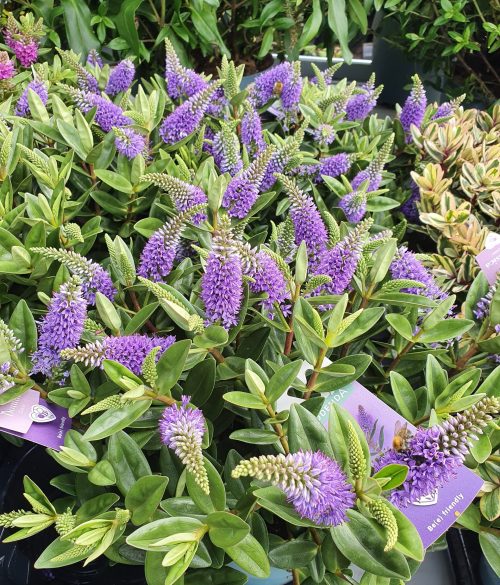 Hebe Donna is a compact evergreen shrub. Mauve blooms appear in July until the first frosts. Deadhead regularly so that more blooms will be produced. Cover with fleece during winter months to protect from frosts. Plant Type: Evergreen Shrub Plant Height & Spread: 100cm x 100cm Foliage Colour: Green Foliage Type: Evergreen Seasons of Interest: All Seasons Soil Condition: Moist, well-drained Planting Position: Full Sun/Light Shade, Sheltered Plant Care & Advice The hebe plant does not require a lot of care once it is established. Although the shrub doesn't need much in the way of fertilizer, you can apply some once a year in late winter or early spring prior to new growth. Growing a hebe plant is very easy. The versatility of these shrubs allows you to grow them in different ways. Use them for edging, plant them in borders, grow them in rock gardens or even in containers. To help keep your Hebe flowering well, remove the dead heads from the plant when they start to shrivel up. You could give your Hebe a trim all over in the early winter. This will help keep your plant attractive and strong.
Hebe Donna is a compact evergreen shrub. Mauve blooms appear in July until the first frosts. Deadhead regularly so that more blooms will be produced. Cover with fleece during winter months to protect from frosts. Plant Type: Evergreen Shrub Plant Height & Spread: 100cm x 100cm Foliage Colour: Green Foliage Type: Evergreen Seasons of Interest: All Seasons Soil Condition: Moist, well-drained Planting Position: Full Sun/Light Shade, Sheltered Plant Care & Advice The hebe plant does not require a lot of care once it is established. Although the shrub doesn't need much in the way of fertilizer, you can apply some once a year in late winter or early spring prior to new growth. Growing a hebe plant is very easy. The versatility of these shrubs allows you to grow them in different ways. Use them for edging, plant them in borders, grow them in rock gardens or even in containers. To help keep your Hebe flowering well, remove the dead heads from the plant when they start to shrivel up. You could give your Hebe a trim all over in the early winter. This will help keep your plant attractive and strong. -
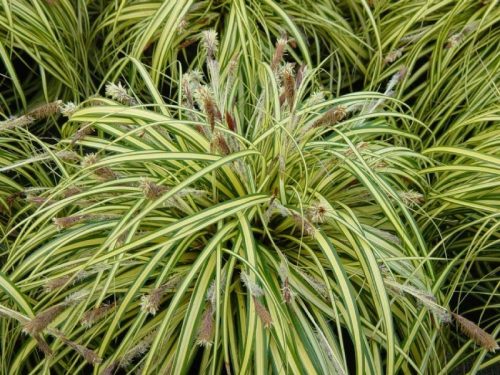
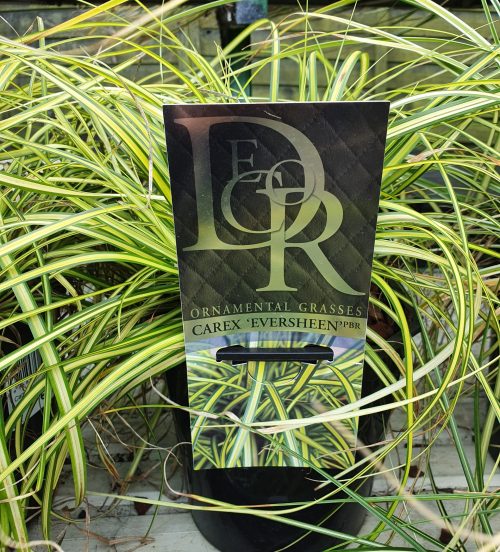 The citrus lemon-yellow blades edged in green add a refreshing zest even in the winter garden. Neat habit is perfect for container planting. Colorful year-round, the flowing arching mounds of Carex Eversheen is perfectly suited for shade, but can handle some sun in cooler climates. A pleasing addition to any spot as it bends and sways with the warm summer breezes. A nice edger. 0.4m height x 0.4m spread
The citrus lemon-yellow blades edged in green add a refreshing zest even in the winter garden. Neat habit is perfect for container planting. Colorful year-round, the flowing arching mounds of Carex Eversheen is perfectly suited for shade, but can handle some sun in cooler climates. A pleasing addition to any spot as it bends and sways with the warm summer breezes. A nice edger. 0.4m height x 0.4m spread -
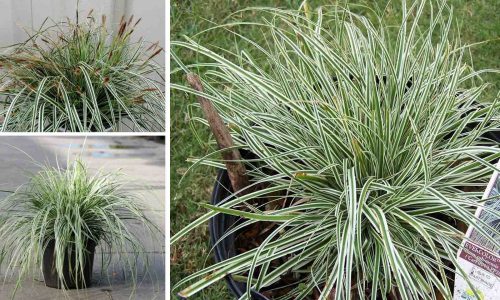
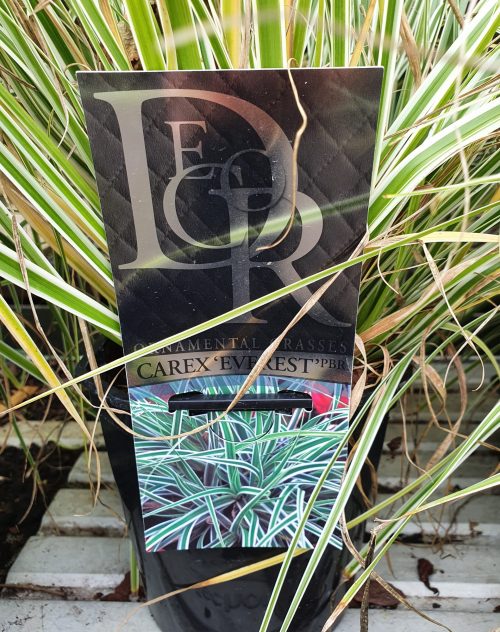 ‘Everest’ is a dense, tufted, evergreen, perennial grass forming a mound of narrow, arching, glossy, dark green leaves with white margins and lax stems bearing brown flower spikes in summer. 0.6m height x 0.6m spread 2-5 years until maturity
‘Everest’ is a dense, tufted, evergreen, perennial grass forming a mound of narrow, arching, glossy, dark green leaves with white margins and lax stems bearing brown flower spikes in summer. 0.6m height x 0.6m spread 2-5 years until maturity -
Out of stock
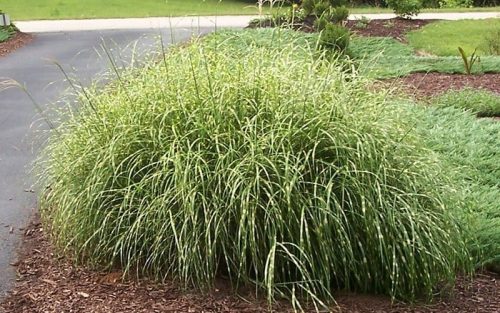
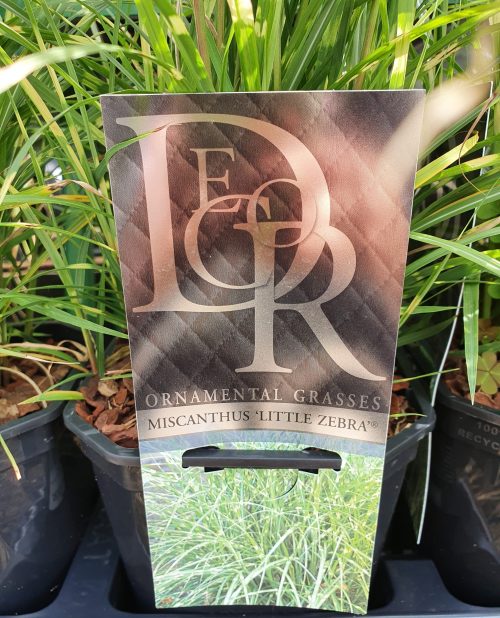 Little Zebra Grass features horizontal gold-and-green bands and a compact, mounding habit. In early fall, this spunky grass sends out attractive reddish, fan-shaped blooms that are held one foot above the foliage. The plumes change to a creamy tan color providing winter interest in the landscape. Because of its size and shape, Little Zebra Grass is the right proportion for small gardens, patios and decks. Its decorative leaves earn it a favored spot in large planters and urns. This sturdy dwarf Miscanthus holds its shape. Miscanthus sinensis ‘Little Zebra’ is unlikely to reseed because of its late-blooming characteristic. Foliage Type: Deciduous. Foliage: Green and Creamy-Yellow. Flower: Pale Pink to Silver. Flowering Period: Late-Summer. Suggested Location: Outdoor or Indoor. Suggested Soil Type: Well-Drained. Sand. Clay. Chalk. Loam. Suggested Exposure to Sunlight: Full Sunlight. Suggested Exposure to Weather: Exposed or Sheltered. Hardiness Rating: High Lowest Temperature Tolerance: -20 °C to -15 °C (-4 °F to 5 °F) Suggested Uses: Rock Gardens. Borders. Containers. Arrangements of Cut Flowers. Maintenance: Remove dead leaves and flowers in spring. Protect against excessive wet weather. Growth Habit: Bushy/Weeping. Growth Speed: Medium (30cm to 50cm per year) Starting Height: 30cm to 60cm (1.0 ft to 2.0 ft) Final Height: 100cm (3.2 ft) Starting Sideways Spread: 20cm to 40cm (0.7 ft to 1.3 ft) Final Sideways Spread: 100cm (3.2 ft)
Little Zebra Grass features horizontal gold-and-green bands and a compact, mounding habit. In early fall, this spunky grass sends out attractive reddish, fan-shaped blooms that are held one foot above the foliage. The plumes change to a creamy tan color providing winter interest in the landscape. Because of its size and shape, Little Zebra Grass is the right proportion for small gardens, patios and decks. Its decorative leaves earn it a favored spot in large planters and urns. This sturdy dwarf Miscanthus holds its shape. Miscanthus sinensis ‘Little Zebra’ is unlikely to reseed because of its late-blooming characteristic. Foliage Type: Deciduous. Foliage: Green and Creamy-Yellow. Flower: Pale Pink to Silver. Flowering Period: Late-Summer. Suggested Location: Outdoor or Indoor. Suggested Soil Type: Well-Drained. Sand. Clay. Chalk. Loam. Suggested Exposure to Sunlight: Full Sunlight. Suggested Exposure to Weather: Exposed or Sheltered. Hardiness Rating: High Lowest Temperature Tolerance: -20 °C to -15 °C (-4 °F to 5 °F) Suggested Uses: Rock Gardens. Borders. Containers. Arrangements of Cut Flowers. Maintenance: Remove dead leaves and flowers in spring. Protect against excessive wet weather. Growth Habit: Bushy/Weeping. Growth Speed: Medium (30cm to 50cm per year) Starting Height: 30cm to 60cm (1.0 ft to 2.0 ft) Final Height: 100cm (3.2 ft) Starting Sideways Spread: 20cm to 40cm (0.7 ft to 1.3 ft) Final Sideways Spread: 100cm (3.2 ft) -
Out of stock
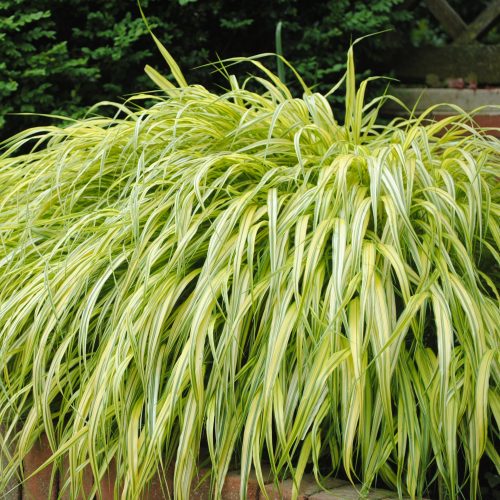
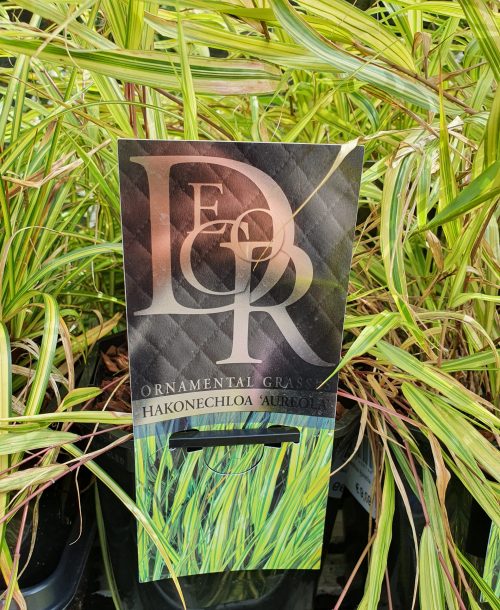 A cultivar of Japanese forest grass which makes a splash of colour in the garden, Hakonechloa macra Aureola is a clump-forming, deciduous, perennial grass which forms a broad, low, dense mound of narrow, arching, rather bamboo-like leaves. They are butter-yellow, striped with green, appear in early spring, keep their bright colour throughout the season, and are often tinged with coppery red in autumn. The colour is best in partial shade, turning shades of green in full shade. Tiny, insignificant, brown flowers appear in summer. Golden hakonechloa is tough, easy-to-grow and very hardy. It holds the RHS Award of Garden Merit. Site: Tolerates exposure Soil: Any moist but well-drained soil Position: Colours best in partial shade; tolerates full sun and full shade Season of interest: Spring to autumn Hardiness: Very hardy Height: 14”’ (35cm) Spread: 16” (40cm)
A cultivar of Japanese forest grass which makes a splash of colour in the garden, Hakonechloa macra Aureola is a clump-forming, deciduous, perennial grass which forms a broad, low, dense mound of narrow, arching, rather bamboo-like leaves. They are butter-yellow, striped with green, appear in early spring, keep their bright colour throughout the season, and are often tinged with coppery red in autumn. The colour is best in partial shade, turning shades of green in full shade. Tiny, insignificant, brown flowers appear in summer. Golden hakonechloa is tough, easy-to-grow and very hardy. It holds the RHS Award of Garden Merit. Site: Tolerates exposure Soil: Any moist but well-drained soil Position: Colours best in partial shade; tolerates full sun and full shade Season of interest: Spring to autumn Hardiness: Very hardy Height: 14”’ (35cm) Spread: 16” (40cm) -
Out of stock
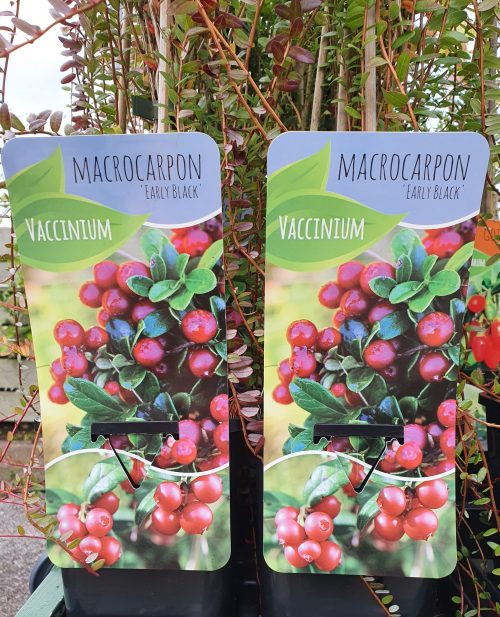
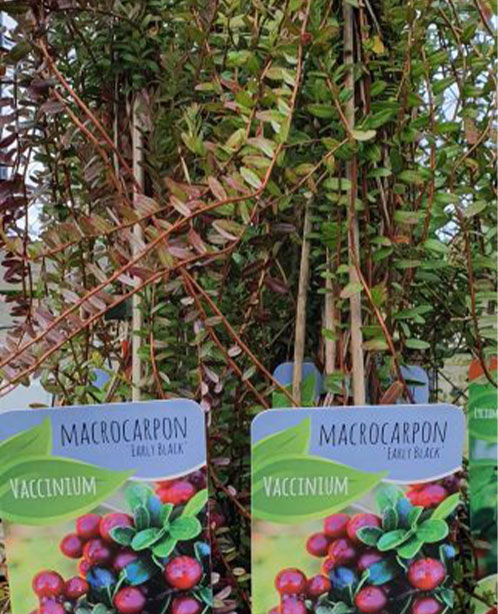 The fruits of 'Early Black' aren't actually black - starting off bright red they ripen to a deep purple-red that could easily be mistaken for black. But it certainly lives up to the 'Early in its name, cropping from late August - which makes it the earliest variety. High in Vitamin C, the fruits can be made into pies and puddings, crushed and made into juice, or made into Cranberry Jelly - perfect for the Christmas Turkey! Growing to a maximum of around 2 feet (60 cm) tall, this small evergreen bush does best in a full sun or a semi-shade position where it can be allowed to scramble as it wishes. Harvest from late August. Suitable for both open ground or container growing. For open ground planting plant 12" x 12" (30 x 30 cm) apart. Ericaceous, so will require soil or compost of an acidic nature. Self-fertile.
The fruits of 'Early Black' aren't actually black - starting off bright red they ripen to a deep purple-red that could easily be mistaken for black. But it certainly lives up to the 'Early in its name, cropping from late August - which makes it the earliest variety. High in Vitamin C, the fruits can be made into pies and puddings, crushed and made into juice, or made into Cranberry Jelly - perfect for the Christmas Turkey! Growing to a maximum of around 2 feet (60 cm) tall, this small evergreen bush does best in a full sun or a semi-shade position where it can be allowed to scramble as it wishes. Harvest from late August. Suitable for both open ground or container growing. For open ground planting plant 12" x 12" (30 x 30 cm) apart. Ericaceous, so will require soil or compost of an acidic nature. Self-fertile. -
Out of stock
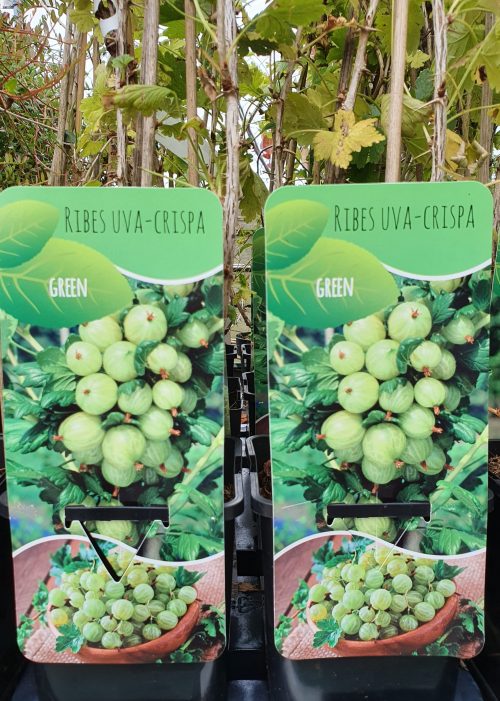
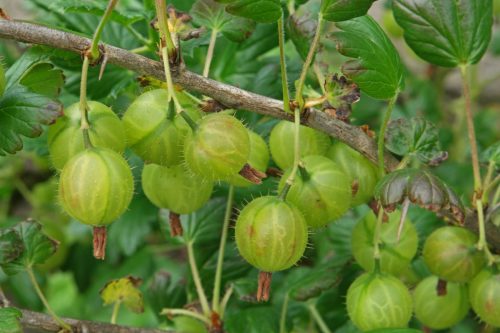
Gooseberries are a staple of the British cottage garden. They’re easy to grow and can thrive in many kinds of soil, as long as they’re grown in full sun. Grow them as compact bushes or train them against a wall. You can also grow gooseberry bushes in containers.Grow in fertile, well-drained soil in a sunny, sheltered site. If growing as a bush, prune gooseberries annually to maintain an open, bowl-shape, which makes picking easier. How to grow Ribes uva-crispa
-
Plant size
1.5m height
1.5m spread
-
Aspect
South facing, west facing
- Sun exposure: Full sun
- Hardiness: Hardy
- Soil type: Well drained / light / sandy
-
-
Out of stock
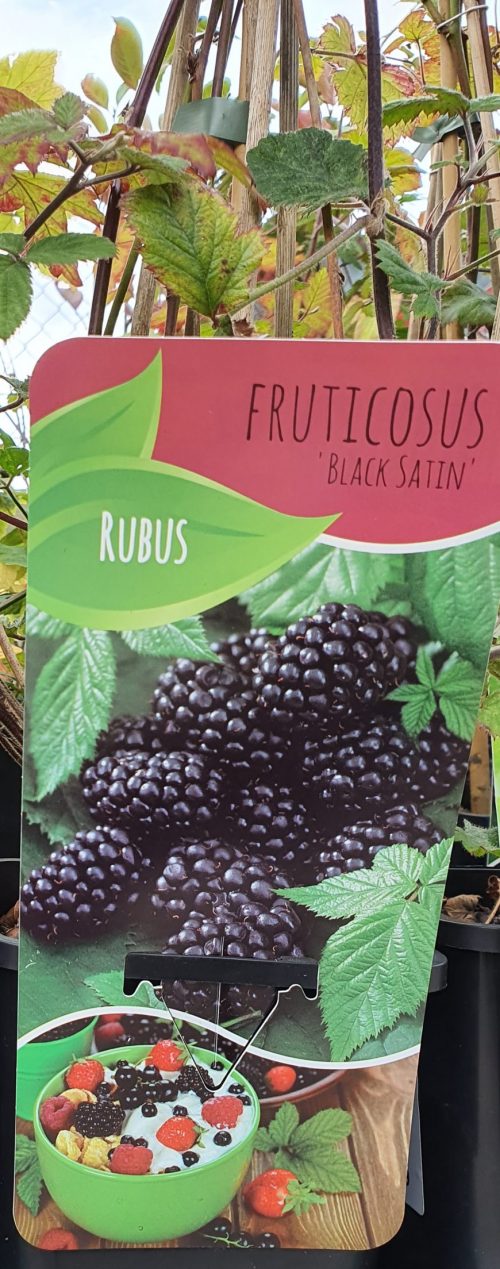
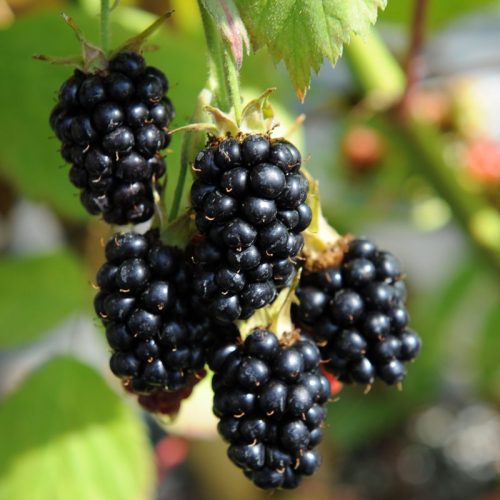 A thornless, American-bred blackberry, Rubus fruticosus Black Satin produces medium to large, rounded, black very juicy berries with a delicious, rather sharp flavour from late July, earlier than most thornless blackberries. Beautiful pale pink flowers and fruit are borne on two-year-old wood; yields are high and reliable. Blackberry Black Satin is a deciduous shrub with upright canes, to 10’/3m, which should be tied into post and wire supports or wires on a warm wall or fence to keep the plant from running rampant and make harvesting easier; cut down fruited canes and tie in new growth after the harvest. Good plant for pollinators. Site: Warm, sheltered, sunny site Soil: Any reasonable, well-drained soil, preferably neutral Position: Full sun Pick: From late July and through August Keep: Fruit does not keep, but freezes well Hardiness: Fully hardy Pollination: Self-fertile Uses: Eating fresh, cooking, preserving
A thornless, American-bred blackberry, Rubus fruticosus Black Satin produces medium to large, rounded, black very juicy berries with a delicious, rather sharp flavour from late July, earlier than most thornless blackberries. Beautiful pale pink flowers and fruit are borne on two-year-old wood; yields are high and reliable. Blackberry Black Satin is a deciduous shrub with upright canes, to 10’/3m, which should be tied into post and wire supports or wires on a warm wall or fence to keep the plant from running rampant and make harvesting easier; cut down fruited canes and tie in new growth after the harvest. Good plant for pollinators. Site: Warm, sheltered, sunny site Soil: Any reasonable, well-drained soil, preferably neutral Position: Full sun Pick: From late July and through August Keep: Fruit does not keep, but freezes well Hardiness: Fully hardy Pollination: Self-fertile Uses: Eating fresh, cooking, preserving -
Out of stock
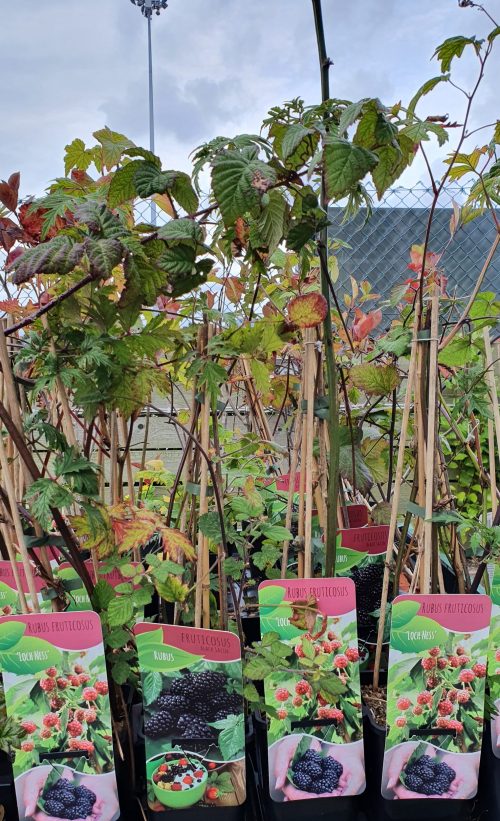
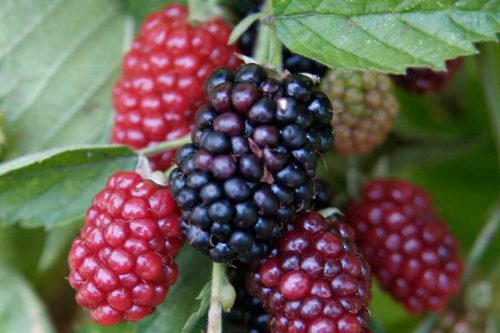 2.5m ht x 2.5m sp 2-5 years until maturity ‘Loch Ness’ is a moderate-sized bush with upright thornless canes, white flowers in summer followed by dark blackberries in late summer.
2.5m ht x 2.5m sp 2-5 years until maturity ‘Loch Ness’ is a moderate-sized bush with upright thornless canes, white flowers in summer followed by dark blackberries in late summer.Foliage
DeciduousHabit
SpreadingFlower
White in SummerFoliage
Dark-green in Spring; Dark-green in Summer; Pale-yellow in AutumnHOW TO CARE
Watch out for
Pests
It is best to rotate crops to avoid pest and disease problems.Specific pests
Aphids , Leafhoppers , Raspberry beetle , Raspberry leaf and bud miteGeneral care
Pruning
Prune old canes to ground level in late winter and tie in new canes.Propagation methods
LayeringWHERE TO GROW
Rubus fruticosus 'Loch Ness' (Blackberry 'Loch Ness') will reach a height of 2.5m and a spread of 2.5m after 2-5 years.Suggested uses
Add to salads, Banks and Slopes, Cake decoration, Containers, Cottage/Informal, Flavouring food and drinks, Hedging/ScreensCultivation
Plant outdoors in summer in well-drained neutral soil.Soil type
Clay, Loamy, SandySoil drainage
Moist but well-drained, Well-drainedSoil pH
NeutralLight
Full SunAspect
South, East, WestExposure
Sheltered -
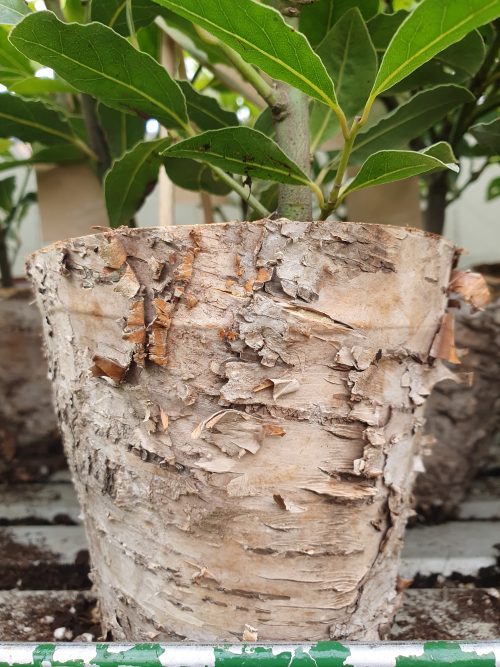
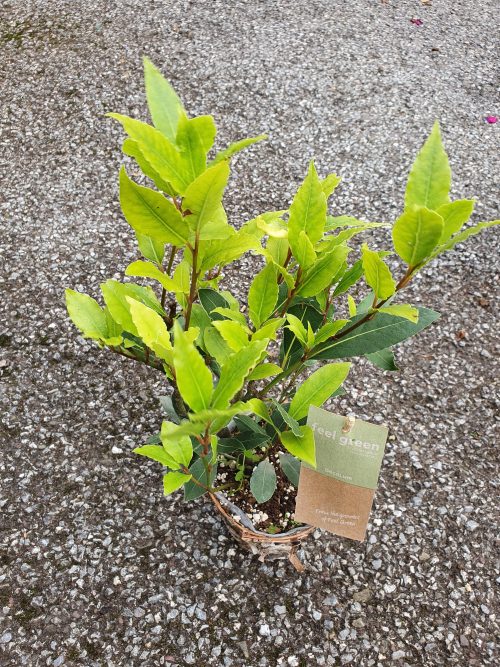 This sustainable laurel adds a Mediterranean touch to your garden (summer)/ house (winter).
This sustainable laurel adds a Mediterranean touch to your garden (summer)/ house (winter).